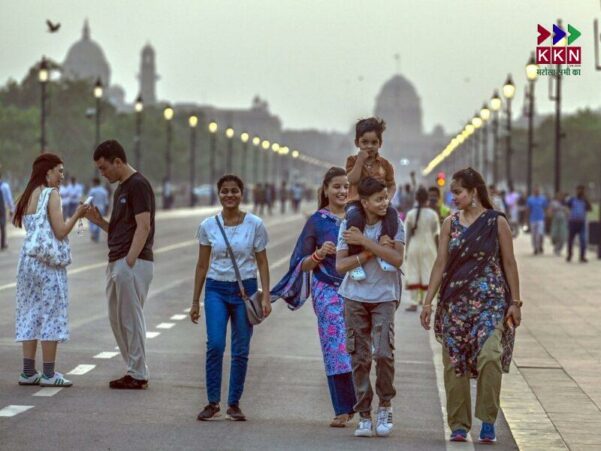
Delhi continues to struggle with severe air pollution levels. For the third consecutive day, the city has witnessed the air quality fall into the “severe” category. On Thursday, the average Air Quality Index (AQI) recorded at 4:00 PM stood at 404. While this was a slight improvement from Wednesday’s AQI of 418, it still remains hazardous, especially for sensitive individuals. These high levels of pollution pose significant health risks, even to those without pre-existing health conditions.
The air quality has consistently remained in the “severe” category despite predictions from the Early Warning System (EWS) that air quality would improve. The system had forecasted “very poor” air quality during the day, but the actual AQI was much higher than expected, remaining above 400 for the third consecutive day. Both Tuesday and Wednesday also experienced AQI levels well above 400, defying the earlier predictions.
Impact of Pollution on Delhi’s Residents
According to the Central Pollution Control Board (CPCB), 28 out of the 39 monitoring stations in Delhi recorded “severe” air quality levels. The worst affected areas were Wazirpur, Chandni Chowk, and Bawana, which reported AQI readings of 458, 453, and 452, respectively. In comparison, only Bahadurgarh and Rohtak, located outside Delhi, recorded worse air quality, with AQI levels of 466 and 430, respectively. These figures underline the critical situation of air quality in Delhi and its surrounding areas.
Weather conditions are a major factor in the persistence of such high pollution levels. Meteorologists have indicated that pollutants remain trapped near the ground due to adverse weather conditions. Mahesh Palawat, Vice President of Skymet Weather, explained that light winds and falling temperatures have created an “inversion layer,” which prevents the dispersion of pollutants. He further added that while there were expectations of stronger winds, the wind speed remained low, at about five to seven kilometers per hour. The absence of wind at night worsened the situation further.
Contribution of Crop Burning and Other Sources of Pollution
Data from the Decision Support System (DSS) revealed that crop burning contributed about 12 percent of the PM 2.5 concentration in Delhi’s air on Thursday. This was lower than the 22.4 percent contribution on the previous day, which had been the highest during the season. While the north-western winds shifted to the west, reducing smoke from Punjab and Haryana, satellite imagery still showed heavy smog over the Indian-Gangetic plains. This dense fog, coupled with the high concentration of pollutants, continues to impact air quality across the region.
CAQM Phase-3 Restrictions in NCR
In response to the worsening air quality, the Air Quality Management Commission (CAQM) Phase-3 restrictions have been implemented across Delhi and the National Capital Region (NCR). These measures have led to a suspension of construction activities in the region. Additionally, older BS-3 petrol and BS-4 diesel four-wheelers are now banned from operating in Delhi, Gurgaon, Faridabad, Ghaziabad, and Gautam Buddh Nagar. These restrictions aim to reduce the overall pollution levels and prevent further deterioration of the air quality.
Schools and Educational Institutions Affected
With the hazardous air quality persisting, primary schools (up to class five) in Delhi have been instructed to continue their classes in hybrid mode until further notice. This decision is part of efforts to minimize the exposure of young children to the harmful effects of air pollution. The ongoing cold and stable winter conditions have only exacerbated the pollution situation, as such weather typically worsens Delhi’s air quality during the winter months.
The minimum temperature in the city was recorded at 10.6 degrees Celsius, which is three degrees lower than the normal average for this time of year. The maximum temperature for the day was 26.3 degrees Celsius. This drop in temperature, coupled with stagnant weather conditions, has made the air quality even worse.
Looking Back at Last Year’s Pollution Levels
Last year, Delhi faced significant air quality challenges in November. During this period, the city recorded eight days of “severe” air quality, with November 18 reaching an AQI of 494. This was the second-highest AQI level ever recorded in the city, highlighting the recurring seasonal issue of air pollution in the national capital. As this year’s air quality worsens, the city may be headed for a similar pattern.
The ongoing situation in Delhi indicates that the city is facing a long battle against deteriorating air quality. The implementation of CAQM Phase-3 restrictions and the suspension of construction activities are essential steps toward reducing pollution levels. However, the weather conditions, combined with factors like crop burning, continue to worsen the situation.
As air quality remains in the “severe” category, residents of Delhi must take necessary precautions to protect themselves from the harmful effects of polluted air. The air quality index will continue to be a crucial indicator of public health, and it will take time and sustained efforts to improve the situation in Delhi.
The authorities and citizens alike need to remain vigilant and proactive in their efforts to combat this pressing environmental issue.


